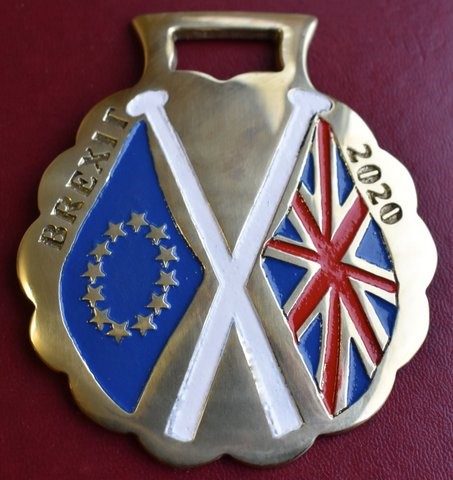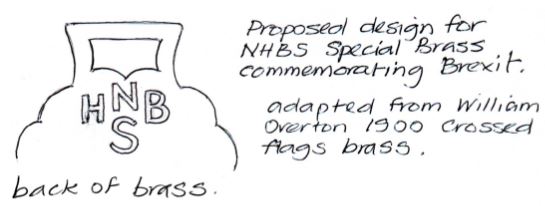Special Brass for Historical Brexit

Brexit 2020 became an
historical fact on Friday January 31st2020. This stunning brass based on the 1900 William
Overton flags brass is being produced as a limited edition by the NHBS and will
be available mid to late March. A
parchment description of the brass and its historical significance will be
supplied with each one. It is expected to be available mid to late March.

Plus Packing and Postage
UK £2.50
Europe £4.60
Rest of World £6.50
Photograph added 26.02.20 
drawings by Peter Ferguson.

Below the William Overton brass cica 1900 front & reverse sides


William
Overton produced a series of brasses in or around 1900 the first of which is
thought to have links with the Boer War and the Relief of Ladysmith, South
Africa. The second brass depicted a
patriotic flag with artistic licence as its identity is not known, both were
engraved on the back WOW (As above). The
NHBS Journal, Horse brass featured these brasses in edition No 4 page 13 in an
article by Derrick Bradbury. In the
picture accompanying the text the brass is shown with the year 1900 cast into
the front, and in the lower section of the crossed flags is the word REGd, the
picture is not clear enough to see a number underneath. It is interesting to note however that the
brass depicted here is without the year but there is a very small number at the
bottom of the crossed flags 35449, it is possible the design carried through
beyond 1900 by just taking the year off. The design was further used for the coronations of Edward VII in 1902
and George V in 1911 with the addition of a crown between the flags. Although they were protected by a registered
number WOW did not appear cast into the back of the brass.
History of the EEC also known as the Common Market
Europe’s
Common market was founded on March 25 1957 when France, West Germany, Italy, the Netherlands, Belgium, and
Luxembourg signed a treaty in Rome establishing the European Economic Community
(EEC), also known as the Common Market
The EEC was
designed to create a common market among its members through the elimination of
most trade barriers and the establishment of a common external trade policy.
The treaty also provided a common agricultural policy which was established in
1962 to protect EEC farmers from agricultural imports. The first reduction in
EEC internal tariffs was implemented in January 1959, and by July 1968 all
internal tariffs had been removed. Between 1958 and 1968 trade among the EEC’s
members quadrupled in value.
Politically,
the EEC aimed to reduce tensions in the aftermath of World War II In
particular, it was hoped that integration would promote a lasting
reconciliation of France and Germany, thereby reducing the potential for war.
The prime Minister Harold Macmillan was alarmed at the rapid economic advances made by France and Germany and sought to join the EEC. Britain's commonwealth ties, domestic agricultural policy, and close links to the US were obstacles in joining and the French President Charles de Gaulle, vetoed Britain's application in 1963. The Wilson government again failed to take Britain into the EEC in 1967 bur Georges Pompidou, who succeeded de Gaulle, finally relented and Britain joined in January 1973 under the premiership of Edward Heath.
The 1974 Wilson government was unhappy with the terms of EEC membership and held a referendum in June 1975. A substantial majority voted in favour of continued membership although Britain consistently resisted supranational industrial, scientific and social policies.
Members revamped the organization several times in order to
expand its policy-making powers and to revise its political structure. On July
1, 1967, the governing bodies of the EEC, ECSC, and Euratom were merged.
Through the Single European Act which entered into force in 1987, EEC members
committed themselves to remove all remaining barriers to a common market by
1992. The act also gave the EEC formal control of community policies on the environment
research and technology, education, health, consumer protection, and other
areas.
The Maastricht Treaty signed on 7 February 1992 reformed and
amended the treaties establishing the European Communities. The treaty founded the European Union and
established its pillar structure beyond economic matters which stayed in place
until the Lisbon Treaty came into force in 2009. The treaty also greatly
expanded the competences of the EEC/EU and led to the creation of the single
European currency, the Euro.
The Lisbon Treaty expanded the number of areas over which
the EU parliament could pass laws, but there are many areas of UK law which are
not covered by EU regulations. The
signing of the Treaty of Lisbon took place Lisbon, Portugal, on 13 December
2007 it came into force 1 December 2009
There can b
 e no
doubt that fears were growing that the huge amount of EU legislation might
result in loss of sovereignty. Furthermore,
immigration had long been a contentious issue in Britain, and the rising costs
of membership especially by the Eurosceptics began to cause thoughts of
withdrawal.
e no
doubt that fears were growing that the huge amount of EU legislation might
result in loss of sovereignty. Furthermore,
immigration had long been a contentious issue in Britain, and the rising costs
of membership especially by the Eurosceptics began to cause thoughts of
withdrawal.
The referendum was first announced by then-Prime Minister David Cameron on 23 January 2013. Cameron announced that he would attempt to re-negotiate
Britain's terms with the EU before holding an in-out referendum no later than
two years after the next general election should
he still be Prime Minister. This was seen as a move to appease Eurosceptics
within his own party as well as an attempt to regain voters who had been
switching allegiance to UKIP since the previous election. Upon the
Conservatives surprise majority victory in the 2015 general election, Cameron
upheld his pledge and announced the date for the referendum to be 23 June 2016.
The UK voted to leave the EU by 52% to 48% majority which was relatively close with many politicians supporting the remain option and it became clear that the government did not have a large enough majority to comply with the outcome of the referendum and David Cameron resigned. Theresa May was appointed to the office of Prime Minister and was then left to implement the outcome of the referendum and with some difficulty Article 50 to take the United Kingdom out of the European Union was signed on 29 March 2017. The remainers still showed a powerful lobby but feelings were running high with the general public that the result of the referen
dum vote should be implemented. Just two years after the previous general election the Prime Minister expecting to win an increased majority went to the polls again on 8 June 2017 but in the event won the election with a decreased majority.
With a hung parliament Theresa May battled on
trying to reach an agreement with the European parliament to reach a deal on
the terms of the UK departure but was unable to obtain sufficient terms to
satisfy the UK government and was left with no option other than to extend the
departure date.
Three years since the referendum had taken
place and also the UK government unable to make any progress on any front,
Prime Minister May was put under severe pressure by the opposition party and
even members of her own Conservative party and left her little alternative than
to stand down as Prime Minister. Boris Johnson was selected by the Conservative Party to replace her and become Prime Minister 24 July 2019

The Brexiters support had grown in strength,
a new Brexit Party was formed
u
n
der the leadership of Nigel Farage. The Brexit Party won the most votes in
the European Parliament election 23-26 May 2019 and
became the largest single national party
Prime minister Boris Johnson battled on
trying to reach a deal with the EU ministers without significant progress. The UK parliament remained in lock down over
leave or remain with the date fast approaching when the UK would be forced to
leave the EU without a deal
Boris Johnson took the gamble of calling a
general election in the attempt to resolve the issue and the 12th
December 2019 saw the third general within six years. with a
Conservative government being returned for a third time with a majority of 80 and
Boris Johnson retaining office as Prime Minister.
The United Kingdom left the European Union (EU) at midnight
on 31 January 2020 (23:00 GMT). On 17 October the UK and the EU reached an
agreement on the conditions for the UK’s departure from the EU (Brexit) and a
transition period. During this period, all EU rules and regulations will
continue to apply to the UK. Virtually nothing will change for businesses
or for the public.